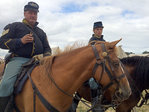
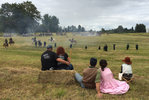
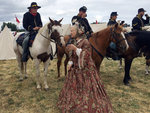


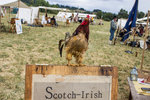
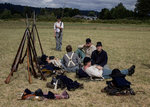





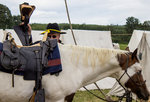
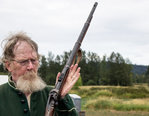
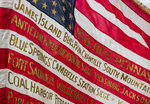
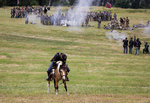



Cannon fire and rifle shots reverberated from the battlefield off Tune Road in Chehalis Saturday as hundreds of history enthusiasts re-enacted one of the final battles of the Civil War.
Participants said re-enactments are the best way to communicate the horrors, triumphs and realities of the Civil War to a modern audience.
“I love history. I have since, I’d say, the eighth grade,” said Darna Michie, whose husband portrayed a Union Army major Saturday. “When history became something more than dates and numbers, that’s when it became interesting.”
The Veterans Memorial Museum in Chehalis has presented the re-enactments each year since 2011 to celebrate the Civil War’s sesquicentennial, or 150th anniversary, said Chip Duncan, executive director of the museum.
“Our mission is to honor veterans. There are no living veterans of the Civil War,” he said. “Once you have veterans passing away, that part of history is relegated to the history books.”
The Veterans Memorial Museum presented the re-enactments in partnership with the nonprofit Washington Civil War Association, which brought about 800 re-enactors to Chehalis over the weekend. The group reenacted battles four times in the weekend.
“By them re-enacting it, it’s helping bring to the limelight and the general understanding of the American people what actually happened,” Duncan said. “It’s the best way to remember them right now.”
On Saturday and Sunday, visitors drove up to the site, less than a mile from Interstate 5, parked their cars in a field, and stepped out of modern times into 1865.
“They’re trying to create an image of what it was like in 1865,” Duncan said.
The re-enactors stay in costume and character for the entire weekend, making their lives as historically accurate as possible for a few days.
Scott Middleton, who portrayed Confederate Gen. Robert E. Lee at the re-enactment of the surrender at Appomattox Saturday and Sunday, said this was his first time taking part in a Civil War re-enactment. He said he was amazed at the re-enactors’ dedication to historical accuracy.
“You don’t stop learning,” he said. “It’s just amazing.”
The re-enactments are historically accurate to a point, but it’s impossible to know exactly what happened at any moment on the battlefield, Duncan said. It’s also impossible to re-enact something exactly as it happened when you’re at a different location than the actual battle, he said.
This gives the re-enactors a chance to be creative, he said.
“Once the shooting starts … it kind of takes on a life of its own,” he said.
Don McConnell, who played Union Gen. Ulysses S. Grant, started participating in re-enactments after he retired as an officer in the U.S. Army.
“It gets in your blood,” he said. “The Civil War in many respects is with us today.”
Some re-enactors, like Middleton, are new to the experience. Others have been replaying battles in the Civil War for decades.
“There’s a lot of reasons why people get into it — sometimes it’s just to get on a battlefield,” Duncan said. “Mostly it’s for educational purposes … and to help us to remember exactly what happened in our national history.”
The re-enactors don’t all fight in the battles. Many played behind-the-scenes roles as family members of soldiers, shopkeepers or battlefield musicians.
Michie was dressed in period attire and acted as a wife of a Union army major. However, in other battles she switches sides and plays a southerner.
She’s not the only re-enactor who switches sides from time to time — even during the same battle.
“There’ll be times when we go into the woods, change uniforms, and the public never knows,” said Bob Wattez, an Oregon resident who said he has participated in re-enactments for 14 years, along with his daughter.
Barbara Smith started participating in re-enactments 17 years ago.
“You see lots of gray hair around here — a lot of people who have been doing it a long time,” she said.
While some women re-enactors play traditional roles, others climb on horses or fire cannons with the men, like Luana Elliott.
“I just like to fight and defend,” she said. “I’ve always been a tomboy.”
While some organizations frown on women playing men’s roles in re-enactments, it’s not without precedent. Some plucky women snuck onto the battlefield and fought alongside men in the Civil War.
“There was one lady who wasn’t found out until she was in the old soldier’s home,” said re-enactor Don Benson.
Duncan said watching a physical representation of the battles in real time — rather than reading about them — makes it easier to understand the nuances of the Civil War.
“The tactics are napoleonic tactics — standing shoulder to shoulder, firing volley after volley,” Duncan said.
While those tactics were effective in the days of smooth-bore guns, which were not very accurate over long distances, they were devastating when combined with the more accurate and powerful rifles used in the Civil War.
“It was a really brutal war that we had never seen before,” Duncan said. “The amount of casualties in the American Civil War is still greater than anything we have combined.”
Watching the battles unfold underscores those horrors, he said.
Last year, re-enactors portrayed the 1864 battle of Petersburg in Chehalis — a particularly deadly and brutal battle fought in trenches.
“It made my hair stand on end,” he said. “Right at the end of the battle … it was just this sea of bodies. It gives you a physical understanding.”